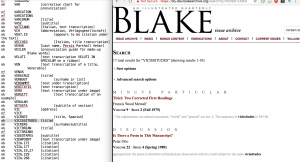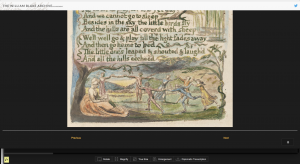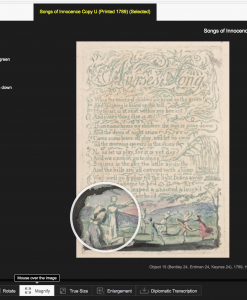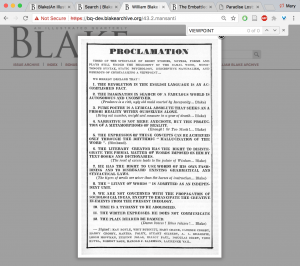I am happy to report that I have finished my last spellcheck list, and will be switching tasks to assist with image mark-up. Not an unwelcome “vicissitude,”

in the sense of the “Grateful vicissitude” of the perfectly-balanced changes from light to darkness that Milton describes in Paradise Lost. But I will miss the curiosities that I came across while checking Blake: An Illustrated Quarterly for spelling errors. For instance, I only read an analysis by Céline Mansanti of an avant-garde writing manifesto, which relied on evidence from Blake, after a search for “VIEWPOINT”:
These accidental finds in Blake: An Illustrated Quarterly has lead me to reflect about the use of digital archives in humanist inquiry, and the exciting, upsetting, or downright bizarre materials that can surface while searching. This summer I presented a paper at the Society for the History of Authorship, Reading and Publishing (SHARP) about a unit that I taught in my first-year composition class at the University of North Carolina at Chapel Hill. For that assignment, I asked students to explore the English Broadside Ballad Archive (EBBA), and then to create narratives about their experiences using the digital archive and to close read particular ballads. Students then used digital tools and resources to write their research papers, and eventually created multimedia essays as part of a password-protected exhibition online. As always, the undergraduate students rose to the challenge. They crafted fascinating arguments about the archival materials they found. Perhaps most interesting to me, however, was their first assignment: a video narrative about their search process and about the resources provided by the archive that they found most useful or interesting.
I plan on teaching the same unit this semester, but will ask students to explore the William Blake Archive instead. In addition to incorporating novelty into grading for me, this project will be an invaluable opportunity to hear about the user experience of undergraduate students. By utilizing the variety tools designed by Michael Fox and other members of the redesign team, students can compare plates from the same matrix:

They can examine details, using the enlargement window or magnify tool:


And they can close read text transcriptions, which is probably the more familiar format from their previous encounters with Blake’s poetry (or with poetry in general), alongside high quality images of the plates:

As students create video narratives about their investigations, I look forward to learning about how they work within a digital space, and about the affordances of the tools in the recently redesigned William Blake Archive.

